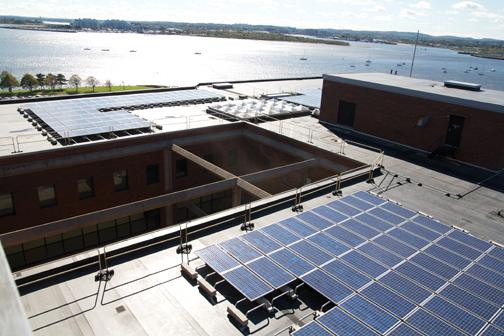In mid-October, 350 photovoltaic (PV) solar panels installed on Wheatley’s fourth floor roof began supplying power to UMB. On the brightest day, during the sunniest hour, the panels can produce 74 kilowatts of energy, and are estimated to produce $10,000 worth of energy annually. In the Wheatley lobby a small TV displays how much power is being generated at any given hour.
The PV panels are part of a statewide project partially funded by a stimulus from the American Recovery and Reinvestment Act (ARRA) of 2009. PV solar panels have been installed on public buildings across the state. The state will spend an estimated $9.9 million on the project.
In eastern Massachusetts, the Department of Conservation and Recreation, Chickatawbut Hill, Massasoit Community College, North Shore Community College, Salem State University, UMass Dartmouth and UMass Lowell, as well as UMB, have been outfitted with panels. Their combined energy-gathering power is estimated to save the state $179,500 annually in energy costs.
In the western part of the state, panels have been installed at Berkshire Community College, Fitchburg State University, Framingham State University, Greenfield Community College, DEP Mass. Recycling, and Westfield State University, with estimated energy cost savings of $129,035 annually.
The Massachusetts Division of Capital Asset Management and the Department of Energy Resources used $121,089 from the ARRA fund to pay for the purchase of the solar panels atop Wheatley. The $214,725 cost of actually installing the panels on the Wheatley building was subsidized through Clean Renewable Energy (CRE) bonds.
Dave Timmons, assistant professor of environmental economics, said that while the monetary value of the project is small, the educational value is large.
“Transitioning to renewable energy sources is very important to society as a whole,” Timmons said. “The university is playing a major part in helping that transition by testing the technology. A financial return is not the main goal of the project, but [UMB] does not operate at a deficit.”
Timmons had his Natural Resources and Sustainable Development Econ/EEOS 345 class generate a financial analysis of the PV solar panel project as it related specifically to UMB.
“[In the case of the solar panel project], all the expense is up front,” Timmons said. “Once they are paid for and in place, they just sit there providing energy. So it becomes a question of the time-value of money, meaning how long before there is a return on the investment and how long will the investment continue to generate income.”
Timmons’ class determined that, over the course of 30 years, the value of electricity from the panels will provide an annual financial return of 4.1 percent. Since the university pays 3.55 percent interest on the CRE bonds, the solar panels will most likely generate enough electricity to cover all their costs, and provide a small net return to the university.
UMB Goes Green
•UMB is a member of the Association for the Advancement of Sustainability in Higher Education (AASHE)
•UMB’s sustainable transit features include eco-friendly buses and discounted transit passes
•Student clubs such as the Sustainability Club created a renewable energy fee to help support renewable energy on campus, funded reusable cups, and promoted green events
•Students can get internships with the UMBe Green Sustainability Program and have access to a green jobs network
•The Chemistry Ph.D. program has a Center for Green Chemistry which involves an ecologically sustainable view of chemical research, development and manufacture
•For more, visit www.umb.edu/in_the_community/sustainability





















































